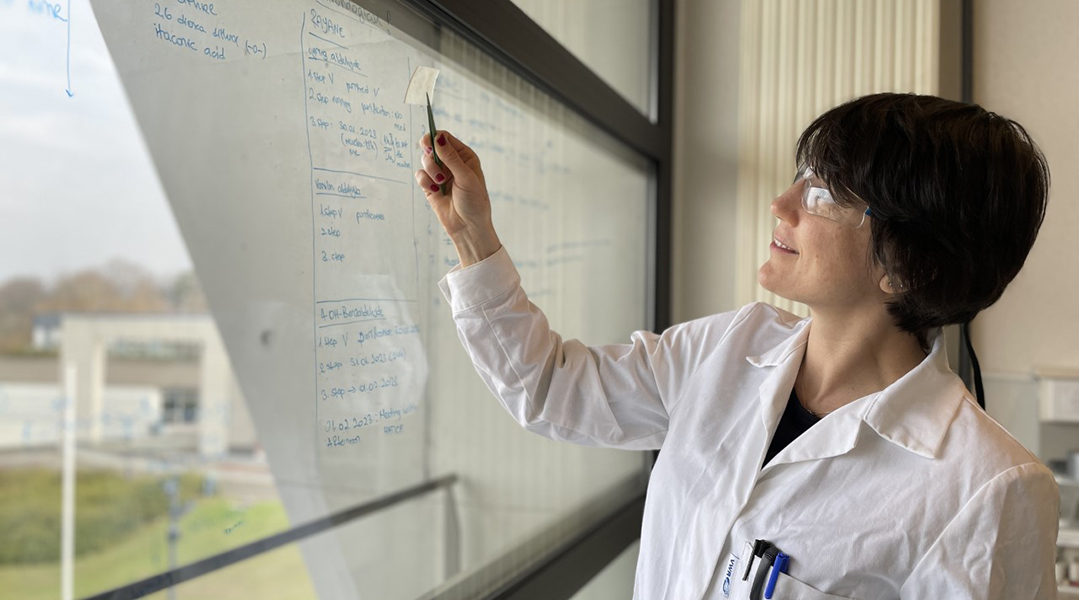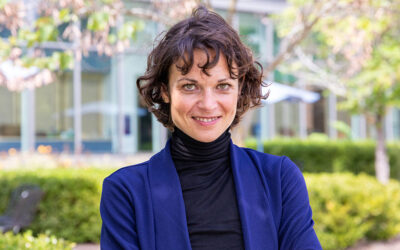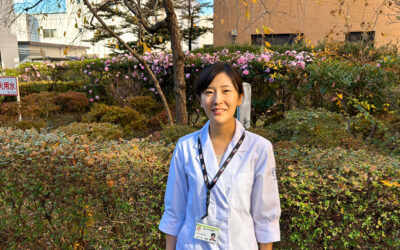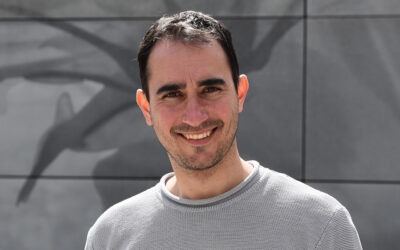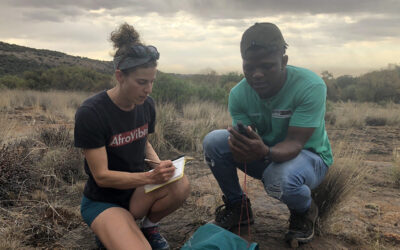A recent recipient of the Macromolecular Rapid Communications Junior Researcher Award, Hatice Mutlu’s research into biodegradable polymers could be a game changer when it comes to the eco-friendly production of polymers.
Her approach to “circular chemistry” is the clear opposite to the conventional linear path many chemists use, with these linear products usually ending up in the bin after they have served their original, short-lived purpose, potentially causing damage to the environment for decades to come.
Mutlu envisions perpetual usage and repurposing of every compound that is needed for polymer production, which would create zero waste. In her approach, after a polymer has served its purpose, it can be broken down into its original building blocks and a new polymer can be generated from them. One can envision future laboratories that produce their own equipment, such as a polymer petri dishes, which can be sterilized, broken down, and then regenerated into something new after their use.
Besides her enthusiasm for polymers, Mutlu is a passionate teacher who is deeply committed to creating opportunities for her students. We sat down with Mutlu to gather insights into her inspiring approach to science.
Can you tell us a bit about your research around biodegradable polymers?
Besides functional and biodegradable, the main idea is to do circular chemistry where everything that is put into the reaction or being produced during a reaction can be broken down and used again, which protects the environment by minimizing waste and resource consumption. With circularity, we are trying to address that something can be reshaped, reused, or recycled so when you use something, you don’t need to throw it out. We are trying to go beyond the take of a “use and throw it away” linear economy and change to a circular economy or circular chemistry.
Therefore, our aim is to intentionally design polymeric materials which not only possess a desired set of physical and mechanical properties, but also can be efficiently deconstruct at the molecular level into monomers or chemical intermediates. Subsequently, those monomers or chemical intermediates will be used to reconstruct plastics, with the goal of closing the loop in plastics recycling and chemical upcycling. To efficiently close the loop, we take advantage of atom- and energy-efficient processes. When we do this, we also keep in mind that the next-generation plastics should ideally exhibit properties equal to or superior to the currently used ones.
I like to use the word “metamorphosis” because we generate materials which can be used for a targeted purpose and upon fulfilling their use or lifetime, they can be transformed to something with completely different functions and properties and fulfill another application.
We try to use simple starting materials which are easily accessible, potentially cheap, and which are stable when you handle them. We convert these easily accessible materials and potentially, if they come from resources that don’t interfere with the environment, convert them to polymers that can further be transformed into a different polymer [after their intended purpose is complete].
What polymers and materials do you generate?
We are trying to transform the oxygen-decorated polymers to their thiol [or sulfur] derivatives, simply because the thiol functional group brings more chemical and physical properties that are different than the oxygen derivatives.
We are trying to develop more efficient approaches that are less negatively impactful on the environment, do not generate waste, and are re-transformable, as well as develop synthetic approaches toward already existing materials that avoid the tedious syntheses.
We use light (ranging from 320 to 490 nm) to catalyze our polymerization reactions because it is simple and easy to control. For our some of our light-based synthesis approaches, we produce water as the only side product. When you remove the polymer that was produced, the reaction environment can be reused.
As an example, we are working with polyester, which is susceptible to degradation. Polythioester is not as susceptible because there are no known enzymes to degrade the thioester bond. Usually, polythioester is obtained through acyl chloride derivatives, which release hydrochloric acid during the reaction process – and which is not so environmentally friendly. Instead, we take carboxylic acids, which are very abundant in nature, and react it with thiol derivatives with the aid of invisible light. We are able to obtain the same polythioester bond without generating the harmful waste.
We are also working with polydithiocarbonates, which are less recognized compared to their oxygen counterparts (i.e., polycarbonates). The introduction of sulfur atoms introduces attractive features, such as high optical property, remarkable chemical resistance, and excellent heavy-metal capture ability. While polycarbonates are already recognized as solid polymer electrolytes for solid-state lithium batteries, the conductivity of neat polycarbonate electrolytes is generally lower compared to the conventional solid polymer electrolytes, such as poly(ethylene oxide) (PEO) and poly(propylene oxide) (PPO).
As the chain segment motion assists the Li+ ion migration, solid electrolytes with a glass transition temperature (the temperature at which the polymers undergo a transition from glassy to rubbery state) below room temperature are essential. Simply, as the lower glass transition temperature (preferentially around -60 °C) denotes more segment mobility and implies a relatively high ion conductivity. That is why, we believe that if you replace the oxygen with the more polarizable sulfur, we not only reduce the glass transition temperature of the solid polymer electrolytes but also enhance the ion conductivity, thus can potentially create more efficient batteries.
I am not a material scientist, but we have collaborators to whom I can give my materials and they can explore the design for targeted applications.
What applications are these polymer materials used for specifically?
Thermosets, such as vulcanized rubber, duroplast, silicone resins — used to make paints and coatings and in electrical and many other applications — and epoxy resins, are irreversibly hardened polymers that cannot be transformed into something else — once their shape is set, they stay like that. Vitrimers, such as epoxy vitrimers used as adhesives, have been known since 2011 and are thermoset-like materials in which there is a programmable unit you can not only re-shape and meal, but also self-heal. When you want to re-shape those materials that are also known for their shape memory behavior, you have to use a external stimuli, such as light, solvent, temperature, or oxidant amongst others.
In our case, we use different light sources to “de-bond” the polymer. You can use one light source to generate them and then a different light source to degrade or to dissemble them. The dissembling process brings us back to the same starting materials that we used to build up the polymer in the first place, making the process now circular.
You take these starting components, which are very accessible and cheap, and you shine light in a solvent under aerobic conditions. The process, which occurs in the presence of oxygen (aerobic), takes about 15 to 20 minutes and starts to build up the polymer. When the polymer is done, it precipitates, and we can reuse the solution again and again, up to three to four times. This means you can have a big container, put in the starting materials and just precipitate the polymer, separate, put in the starting materials, synthesize, separate, and reuse it continuously.
When you want to disassemble the polymer, you shine the former or different light source in a distinctive solvent. If you don’t want to degrade to the starting components, you can also reshape the polymer you already have by using different derivatives in bulk.
With our approach we are able to produce gram scales now, but the target is go to kilogram scales. We just need the proper light setup for this adjustment. The fact that we are already working on a gram scale tells us this is realizable on the industrial level.
My motto is do not complicate your life by considering complex setups. Use what you have in hand.
Recently you published an article that dealt with the avoidance of pollution and environmental depletion in research. How can chemists, scientists, and industry successfully protect the environment while still doing effective research?
We wrote this very nice perspective with Professor Leonie Barner (QUT) as we both are passionate about chemistry and sustainability. With this article, we wanted to emphasize that green chemistry and sustainable chemistry, along circular chemistry are important concepts not only for the modern lifestyle, but also for worldwide industries. We wanted also to draw the attention that those three concepts are closely related and interconnected, still they serve different economies, i.e., linear and circular economy, and cannot be used synonymously.
Thus, in my point of view, a key aspect to “successfully” protect the environment in the long term while still doing effective research requires the collaborative effort of a diverse group of scientists on the fundamental questions addressing not only green chemistry but in general the concept of circular (polymer) economy/chemistry.
How are your products broken down to be reused? Is it an intensive process?
What we know is that commercial plastics are not recycled in a closed-loop, circular manner. If I need to give numbers, currently it is estimated that 95% of the economic value of plastics is lost to the environment after a single use. This is because we were/are still lacking methods to selectively deconstruct polymers back to their original monomers, although there are some exceptions, e.g., PET.
Accordingly, you can imagine that the challenge is to design new highly efficient bond-forming reactions for the preparation of high–molecular-weight polymers that can be efficiently deconstructed to their virgin-grade monomers or “metamorphosed” into a new chemical species or into a new monomer. Importantly, the latter ones should be used to reconstruct plastics, with the goal of closing the loop in plastics recycling and chemical upcycling.
For this purpose, we take advantage of atom- and energy-efficient (light-induced) processes. The intensity of the process is dependent on the functional groups integrated in the polymers. For instance, in the case of the previously mentioned polydithiocarbonates, a very simple metamorhopsis can be quantitatively achieved via UV-induced photolysis at room temperature or by chemolysis at 50 °C.
Can you share some future research plans?
I want to take advantage of using CO2 in addition to oxygen and light [to bulid polymers]. We can clearly observe that converting CO2 into high-value-added fuels or materials has attracted broad interest. In similar manner the utilization of CO2 to produce polymeric materials is becoming highly desirable as diverse functional groups (carbonate, ester, etc) with many unique properties could be generated. Accordingly, we are also passionate to valorize CO2 for the synthesis of photo-polymerizable monomers. The visionary idea is also to take advantage of existing plastic waste materials.
Another waste material is elemental sulfur, which is a side product in the petroleum industry. Each year, 600 Eiffel Tower-sized piles of elemental sulfur are generated. The amount of sulfur which we collect each year as landfill waste is accumulating and accumulating. Not many laboratories in Europe are working on this and so we want to take advantage to use elemental sulfur and CO2 and make them useful and transformable into (high) sulfur content polymers for sustainability, energy and defense.
There are new technologies like 3D printing, and even 4D printing, where we could find suitable formulations for our materials to be used as ink, for example.
What is the most valuable advice you would give future generations of scientists?
Whatever happens, believe in yourself. This inner voice, this gut, is always right even though many of us underestimate ourselves. Under normal circumstances, I am a very stressful person, but when there is a challenge on the scientific level, I immediately start looking for solutions everywhere.
Also, many in the younger generation of students or scientists are afraid to contact well-known scientists. They need to remember that well-known scientists are also human beings, and they were the same years ago and networking with them is so important.
What is a place you would love to visit?
I would like to visit Norway and New Zealand and explore nature, and in particular the mountains, in each country.
What is a hobby you pursue in your free time?
My main hobbies are hiking, biking and anything similar and I like to read or watch about Sherlock Holmes. His genius ability to map out and connect clues really inspires me. I am also trying to snowboard, and I am not the best at it, but it helps me find myself in nature throughout the year.
Who would play you in a biopic?
I would like Marion Cotillard to play me because people say I really resemble her, and we have similar body language. Some say Marion can be pushy and I can be also pushy, but only because sometimes my brain is faster than my mouth and my motivation presents itself strongly or I realize my students do not see their full potential and then inevitably I push them to discover it.
What is a song you could constantly listen to?
I could listen to ‘The Show Must Go On’ from Queen continuously.
Who is a person, famous or not, you would like to meet?
I would love to meet Marie Curie because of her character, motivations and dedication. She really sustained herself and her ambition against a whole society and a world dominated by male scientists.
I also admire Tanja Junkers, as an individual who has been striving to unlock her own human potential and build a better, more informed, and more equitable future. I really appreciate her and the steps she took to become who she wanted to be. We ourselves should not put things into one static shape.
Feature image credit: Cuong Minh Quoc Le

